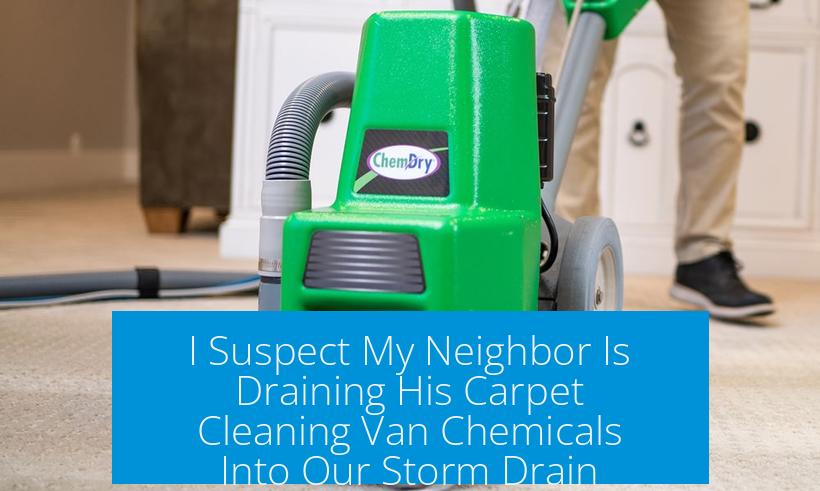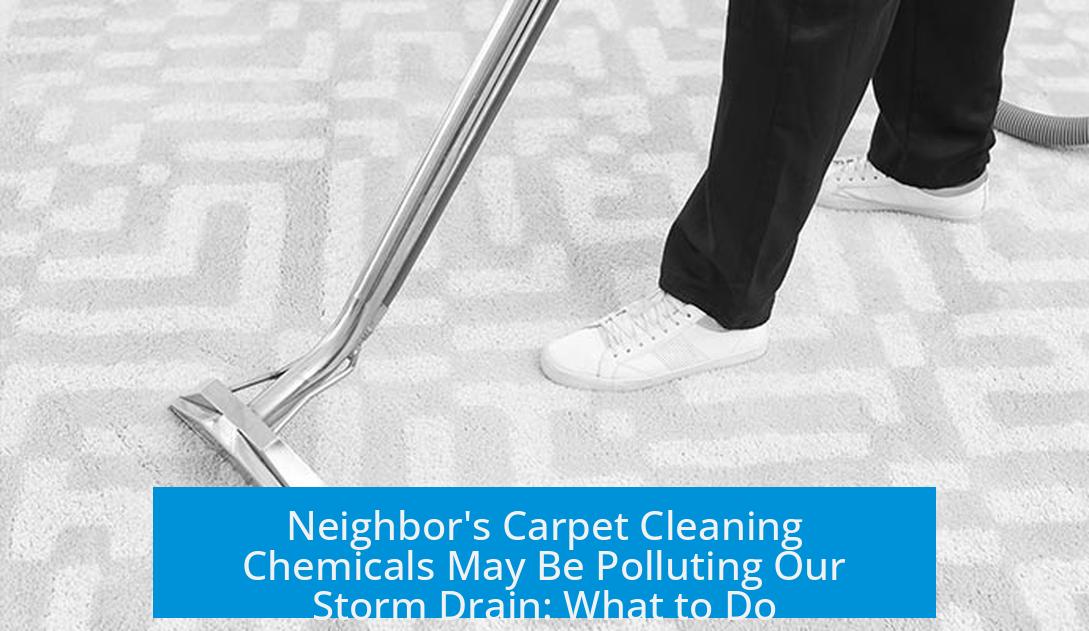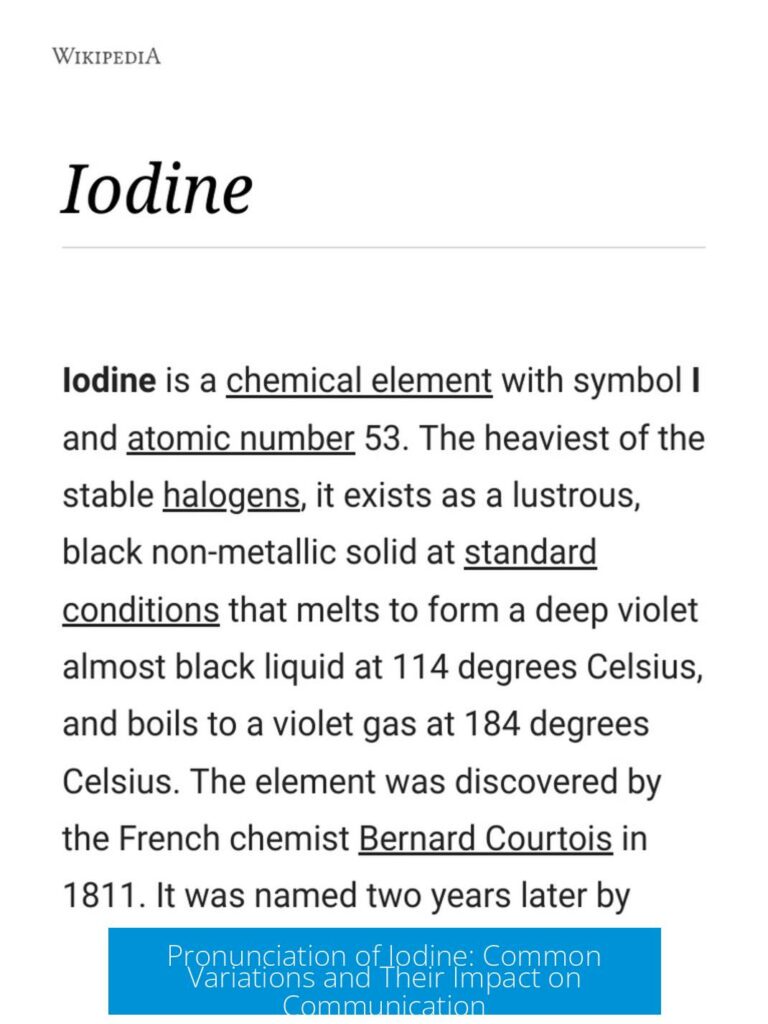I Suspect My Neighbor Is Draining His Carpet Cleaning Van Chemicals Into Our Storm Drain

It is illegal to drain carpet cleaning chemicals into storm drains in many jurisdictions. Reporting the suspected illegal discharge to local environmental or water authorities is the appropriate step. Professionals can investigate, test, and take action if necessary. Handling wastewater properly is a regulatory requirement, and unauthorized dumping damages water quality and ecosystems.
Legality of Draining Chemicals Into Storm Drains
Draining carpet cleaning chemicals or any non-rainwater substance into a storm drain is prohibited in many municipalities. Storm drains typically direct untreated water directly to local waterways, bypassing sewage treatment plants. This makes dumping chemicals into these drains harmful to aquatic life and public health.
- Most local laws restrict storm drains to receiving rainwater only.
- Discharging cleaning chemicals can contaminate streams, rivers, and groundwater.
- Even pool water, containing disinfectants like chlorine, is often banned from storm drains.
- Illegal dumping violates local and environmental regulations and can result in fines.
Reporting Procedures and Authorities
Concerns about illegal chemical dumping belong with city or county authorities responsible for water quality and environmental compliance.
- Contact your city’s water department or environmental compliance division.
- Many cities have a dedicated stormwater management or stormwater pollution prevention office.
- The Environmental Protection Agency (EPA) may also be involved if local authorities lack jurisdiction.
- Some areas provide online portals or hotlines to report pollution complaints.
Gather any evidence you can—photos, videos, dates, times—but avoid confrontation or personal testing. Authorities have the expertise and legal power to investigate and enforce.
Practical Handling of Wastewater in Carpet Cleaning
Professionals in carpet cleaning and disaster restoration strictly control wastewater disposal. Their procedures include:
- Collecting wastewater in designated tanks during cleaning operations.
- Disposing of the collected water only at approved facilities or drains connected to the sanitary sewer system, not storm drains.
- Regular training to ensure compliance with environmental laws.
- Avoiding direct discharge into municipal drainage systems to prevent pipe damage and pollution.
This approach prevents chemical contamination of local waterways and avoids legal violations and costly penalties.
Testing and Verification of Suspected Discharges
DIY Observations
Laypersons may notice indicators of chemical dumping:
- Visual anomalies like foam, unnatural colors, or oily sheens in the storm drain water.
- Smells reminiscent of cleaning agents or chlorine.
- Persistent bubbles indicating surfactants or detergents.
Simple observation can support suspicion, but chemical identity and concentration require professional analysis.
Why Professional Testing Is Advised
Testing hazardous substances and enforcing environmental laws need specialized equipment and expertise:
- Certified labs can analyze water samples for detergents, solvents, and toxic pollutants.
- Professionals ensure sampling methods preserve sample integrity and chain of custody.
- Authoritative test results can trigger enforcement actions and fines.
Some local environmental testing facilities or pool supply stores offer water testing. However, contacting municipal authorities to handle testing is often more prudent and effective.
Environmental Impact of Improper Chemical Disposal
Discharging carpet cleaning waste into storm drains poses substantial risks:
- Storm drains often discharge untreated to streams and rivers, directly affecting aquatic ecosystems.
- Detergents and solvents can be toxic to fish, invertebrates, and plant life.
- Chemical buildup can disrupt ecosystems and contaminate drinking water sources.
- Environmental damage may violate state and federal clean water laws.
Proper disposal reduces chemical pollution and preserves local water quality for communities and wildlife.
Addressing the Issue With Your Neighbor
Approach any personal interactions carefully:
- Consider asking your neighbor directly about their discharge practices.
- Maintain a calm, non-accusatory tone to avoid escalating tensions.
- Recognize that your neighbor may be unaware of regulations or consequences.
- Regardless of personal relations, reporting to authorities remains crucial if illegal dumping continues.
A professional resolution protects neighborhood health and environment without personal conflict.
Summary Table: Key Steps to Take
| Step | Action | Purpose |
|---|---|---|
| 1. Observe and Document | Take notes, photos, or videos of suspicious discharge. | Supports a formal complaint with evidence. |
| 2. Avoid DIY Chemical Testing | Do not attempt to chemically test the wastewater yourself. | Prevents errors and legal issues; leaves testing to professionals. |
| 3. Contact Authorities | Report your concerns to your city’s water or environmental department. | Triggers official investigation and enforcement actions. |
| 4. Optional: Consult Testing Labs | Use certified labs for professional water sampling if desired. | Provides concrete evidence to support claims. |
| 5. Engage Neighbor Respectfully | Discuss your concerns politely and gather information. | May resolve misunderstanding or encourage compliance. |
Key Takeaways
- Draining carpet cleaning chemicals into storm drains is illegal and environmentally hazardous.
- Authorities such as city water departments or environmental agencies must handle investigations.
- Professional wastewater disposal practices avoid damage and comply with laws.
- Laypersons should avoid chemical testing and instead report suspicious activity.
- Environmental damage from improper disposal affects ecosystems and community health.
- Maintain respectful communication with neighbors but prioritize official reporting.
Q1: Is it illegal for my neighbor to drain carpet cleaning chemicals into the storm drain?
Yes. Most places allow only rainwater in storm drains. Draining carpet cleaning chemicals there is usually illegal. It can harm the environment and violate local laws.
Q2: Who should I contact to report suspected illegal chemical dumping?
Contact your city’s water or stormwater department. Environmental compliance agencies or the EPA can also help. They handle investigations and may issue fines.
Q3: Can I test the water myself to prove dumping is happening?
It is not advised to test water yourself. Professionals have the right tools and knowledge. Instead, collect any visual evidence and report to authorities for proper testing.
Q4: What environmental impacts can dumping chemicals into storm drains cause?
Chemicals can poison waterways, harm aquatic life, and damage ecosystems. Chlorine or detergents in carpet cleaning liquids are especially harmful when released untreated.
Q5: Should I talk to my neighbor before reporting the issue?
Approach with caution. Sometimes neighbors are unaware of laws. A direct talk might clarify the situation. However, persistent dumping should be reported regardless.
Q6: How do professional carpet cleaners handle wastewater from their vans?
They use tanks to store dirty water and dispose of it at approved facilities. Dumping directly into storm drains is avoided to comply with regulations and protect infrastructure.





Leave a Comment